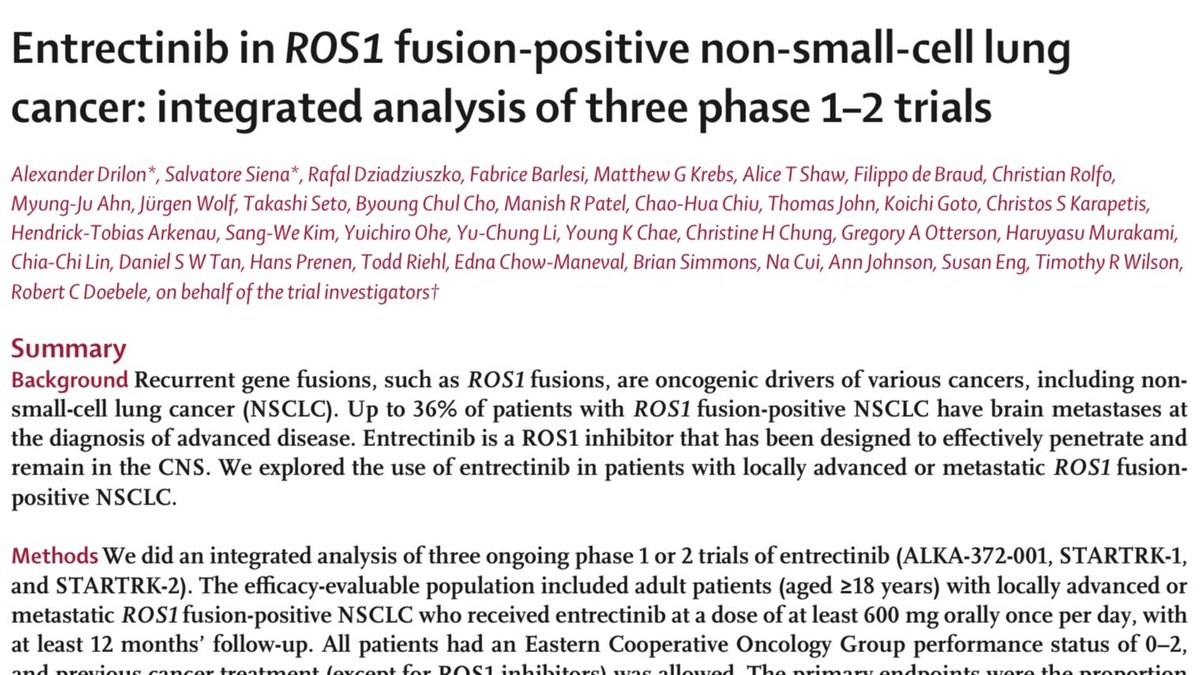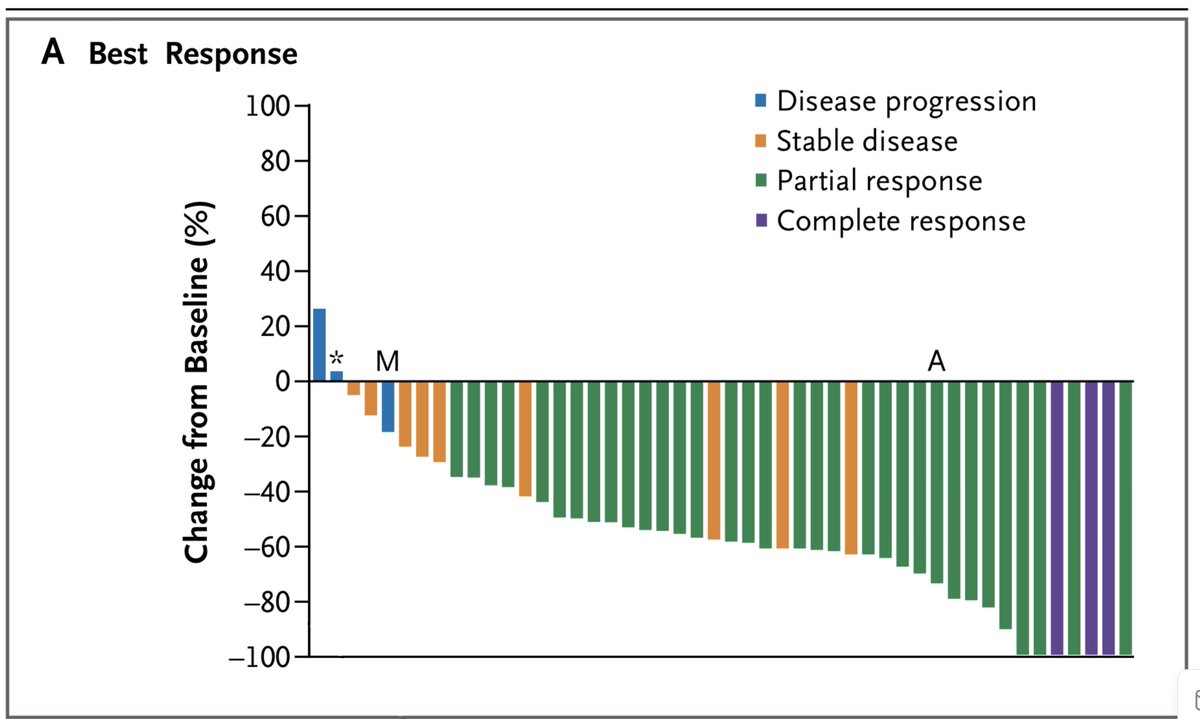Discover and read the best of Twitter Threads about #LCAM
Most recents (24)
I wish it wasn't so, but surgical procedures disrupt tumors leading to hematological dissemination and the need for more treatment. Here, a randomized trial reports efforts to reduce this risk. jtcvs.org/article/S0022-… 1/ 🧵 
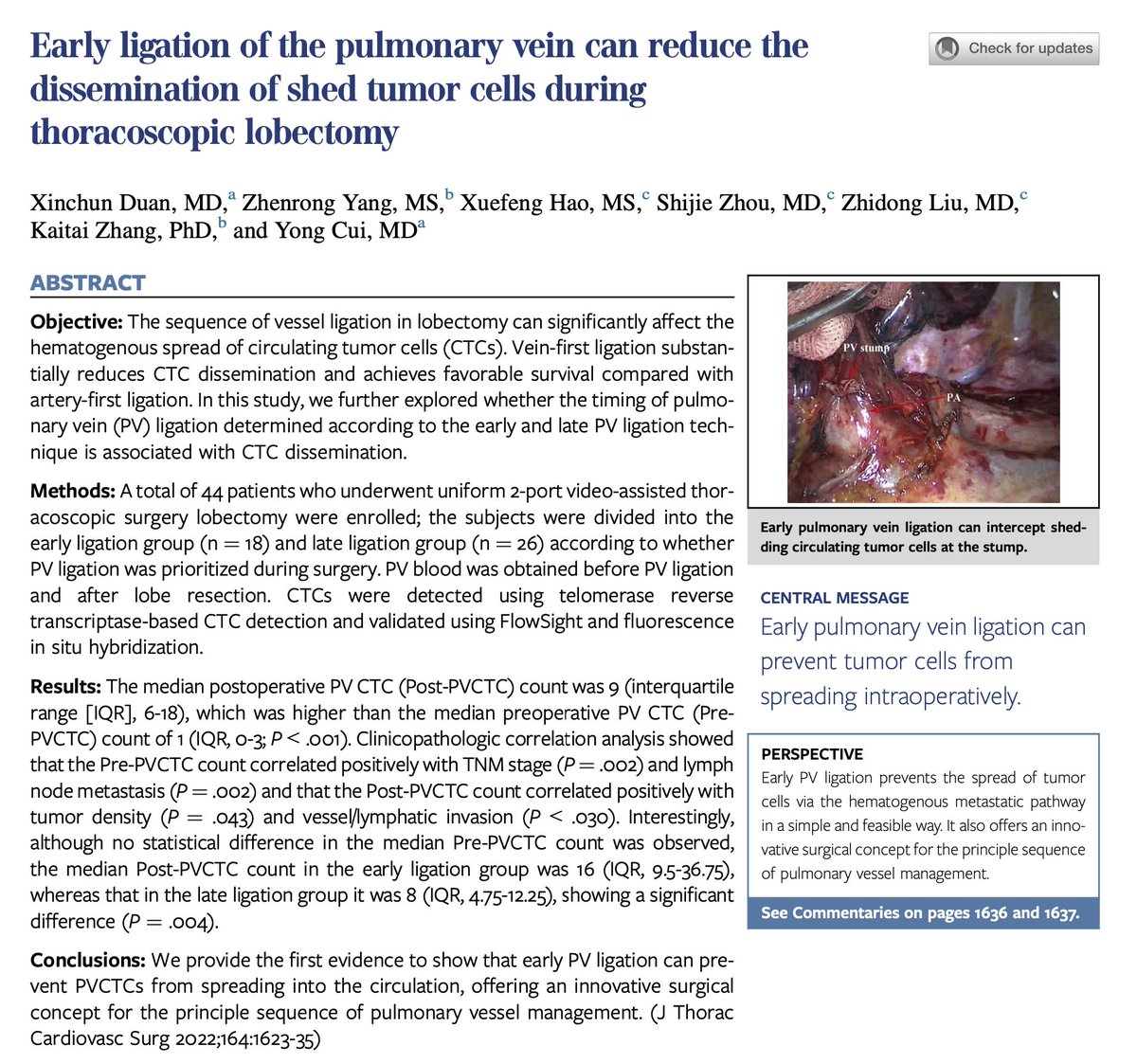
Sadly, contemporary trials show that surgical removal of even the smallest lung cancers (≤2 cm) cannot cure most patients. Note that neither of the DFS curves shows a sign of plateauing. @AltorkiNasser 



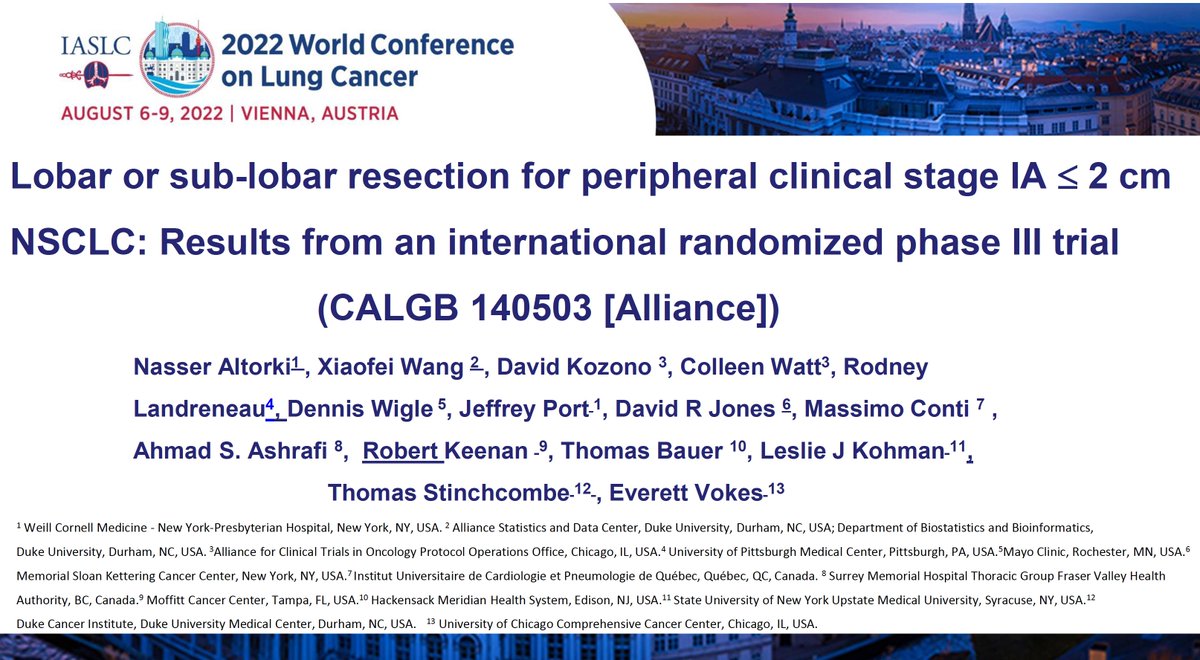
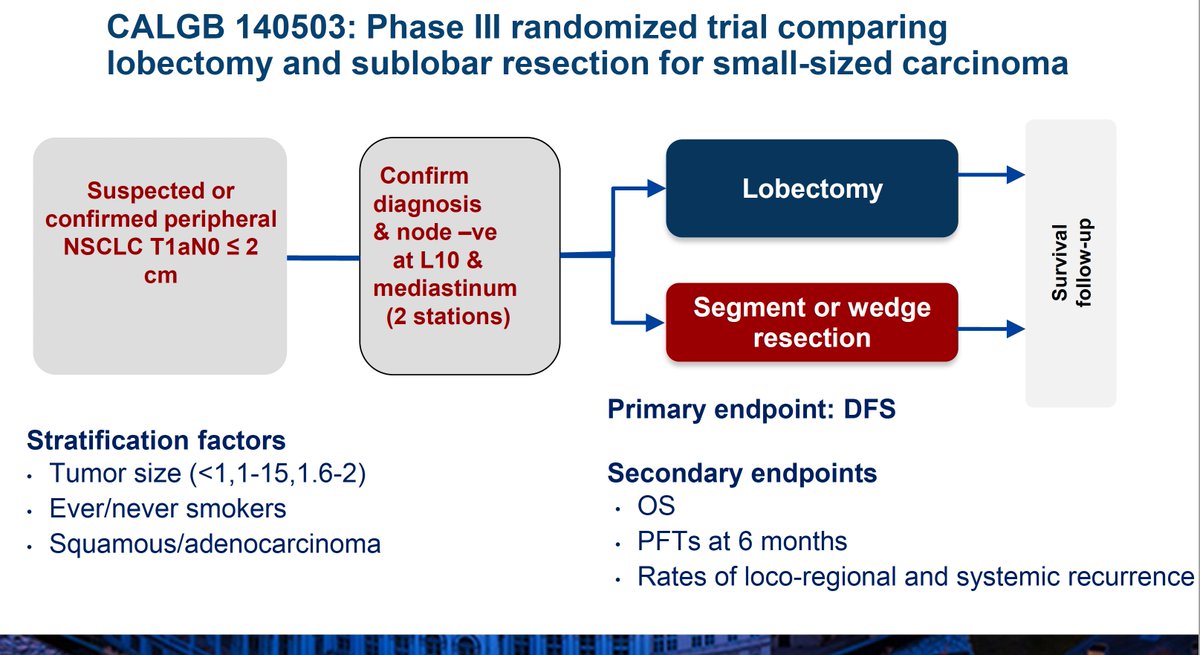


@TumorBoardTues 1/17 #TumorBoardTuesday #LungCancer #OncTwitter
42yo 👨🏽💼
PMH: never smoker
persistent cough
🩻PET/CT: 3.5 cm mass LLL & bulky, coalescing LNs in L hilum & mediastinum (AP 🪟, subcarinal, bilat paratracheal, supraclav)
Axillary LNs
🦴multi bony mets
🫀small pericardial effusion
42yo 👨🏽💼
PMH: never smoker
persistent cough
🩻PET/CT: 3.5 cm mass LLL & bulky, coalescing LNs in L hilum & mediastinum (AP 🪟, subcarinal, bilat paratracheal, supraclav)
Axillary LNs
🦴multi bony mets
🫀small pericardial effusion
@TumorBoardTues 2/17 #TumorBoardTuesday #LungCancer #NSCLC
🫁🎥Mediastinoscopy shows adenocarcinoma with signet rings.
🔬 ALK IHC positive
🐟 FISH positive
🧬 PDL1 = 0
🤨What’s your recommended initial therapy:
🫁🎥Mediastinoscopy shows adenocarcinoma with signet rings.
🔬 ALK IHC positive
🐟 FISH positive
🧬 PDL1 = 0
🤨What’s your recommended initial therapy:
@TumorBoardTues 3/17 #TumorBoardTuesday #LCSM
🧲MRI: Brain shows 4 CNS mets in frontal lobes & cerebellum
📏 = 13, 10, 8 and 4 mm
💧No edema
🧠 no neuro symptoms
🤨 Does the presence of CNS mets change your 1st line recommendation?
A = alectinib
B = brigatinib
L = lorlatinib
🧲MRI: Brain shows 4 CNS mets in frontal lobes & cerebellum
📏 = 13, 10, 8 and 4 mm
💧No edema
🧠 no neuro symptoms
🤨 Does the presence of CNS mets change your 1st line recommendation?
A = alectinib
B = brigatinib
L = lorlatinib
30 November: IMpower, adieu
This year for Lung Cancer Awareness Month #LCAM I’m going to summarize 30 important lung cancer trials over 30 days. These posts are directed at non-medical professionals, with descriptions of the results and of what makes a good trial. #lcsm 1/12
This year for Lung Cancer Awareness Month #LCAM I’m going to summarize 30 important lung cancer trials over 30 days. These posts are directed at non-medical professionals, with descriptions of the results and of what makes a good trial. #lcsm 1/12

I thought we’d close out the month with a trial that’s so new that its impact is not yet agreed upon, and its findings have not ossified into standard practice. It combines two strands that have run through the month: benefit of adjuvant therapy, and the advance of immunotherapy.
We have seen immunotherapy improve outcomes in metastatic NSCLC (Nov 13, 18) and locally advanced NSCLC (22 Nov) . This study moves immunotherapy earlier, into the adjuvant setting (see November 2, 14, 17, 25 for other adjuvant studies). 3/12
29 Nov: Chemo/gefitinib, randomized phase II
For Lung Cancer Awareness Month #LCAM I’m going to review 30 important lung cancer trials over 30 days. These posts are directed at non-medical professionals, with descriptions of the results and of what makes a good trial.#lcsm 1/11
For Lung Cancer Awareness Month #LCAM I’m going to review 30 important lung cancer trials over 30 days. These posts are directed at non-medical professionals, with descriptions of the results and of what makes a good trial.#lcsm 1/11

All of the randomized studies we’ve looked at to date have been phase III studies, meaning that they are randomized studies with sufficient statistical power to demonstrate a clinically meaningful difference. Today we’ll look at a randomized phase II study. 2/11
Traditionally, phase II studies were preliminary studies done to see if a treatment approach was promising enough to warrant a proper phase III trial. They were single arm, and considered “positive” if they met some pre-specified level of treatment activity. 3/11
28 November: ROS1, single arm trials
For Lung Cancer Awareness Month #LCAM I’m going to summarize 30 important lung cancer trials over 30 days. These posts are directed at non-medical professionals, with descriptions of the results and of what makes a good trial. #lcsm 1/15
For Lung Cancer Awareness Month #LCAM I’m going to summarize 30 important lung cancer trials over 30 days. These posts are directed at non-medical professionals, with descriptions of the results and of what makes a good trial. #lcsm 1/15
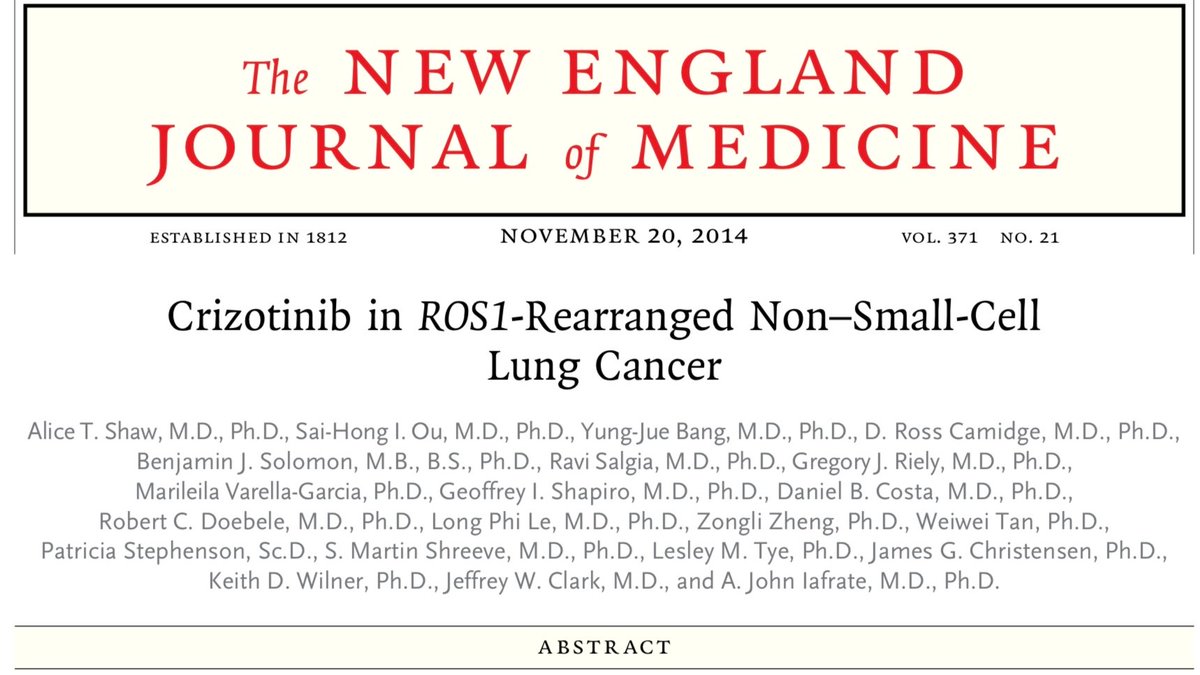
27 November:Temel, QoL outcomes
This year for Lung Cancer Awareness Month #LCAM I’m going to summarize 30 important lung cancer trials over 30 days. These posts are directed at non-medical professionals, with descriptions of the results and of what makes a good trial.#lcsm 1/19
This year for Lung Cancer Awareness Month #LCAM I’m going to summarize 30 important lung cancer trials over 30 days. These posts are directed at non-medical professionals, with descriptions of the results and of what makes a good trial.#lcsm 1/19

Today’s trial is one of the most thought-provoking of the month, and it has been discussed widely since its publication in 2010. It is a trial looking at the timing of referral to palliative care for people with advanced, incurable lung cancer. 2/19
Many people hold the view that palliative care is care at the end of life. While this is a component of it, palliative care physicians are experts in controlling symptoms, which is valuable in a highly-symptomatic disease like metastatic lung cancer. 3/19
26 November: Biases and negative studies
For Lung Cancer Awareness Month #LCAM I’m going to summarize 30 important lung cancer trials over 30 days. These posts are directed at non-medical professionals, with descriptions of the results and of what makes a good trial. #lcsm 1/12
For Lung Cancer Awareness Month #LCAM I’m going to summarize 30 important lung cancer trials over 30 days. These posts are directed at non-medical professionals, with descriptions of the results and of what makes a good trial. #lcsm 1/12

Today we are returning to small cell lung cancer, a disease that we previously considered on 10 November.
We discussed how limited-stage disease can be treated with curative intent chemoradiotherapy, while extensive stage disease is treated palliatively with chemotherapy. 2/12
We discussed how limited-stage disease can be treated with curative intent chemoradiotherapy, while extensive stage disease is treated palliatively with chemotherapy. 2/12
Like many other cancers, treatment of small cell lung cancer has been altered by immunotherapy. There are clinical trials of durvalumab (22 Nov) and atezolizumab showing that adding them to chemo improves survival modestly. This evidence is reflected in most treatment guidelines.
25 November: LACE meta-analysis
This year for Lung Cancer Awareness Month #LCAM I’m going to summarize 30 important lung cancer trials over 30 days. These posts are directed at non-medical professionals, with descriptions of the results and of what makes a good trial. #lcsm 1/12
This year for Lung Cancer Awareness Month #LCAM I’m going to summarize 30 important lung cancer trials over 30 days. These posts are directed at non-medical professionals, with descriptions of the results and of what makes a good trial. #lcsm 1/12
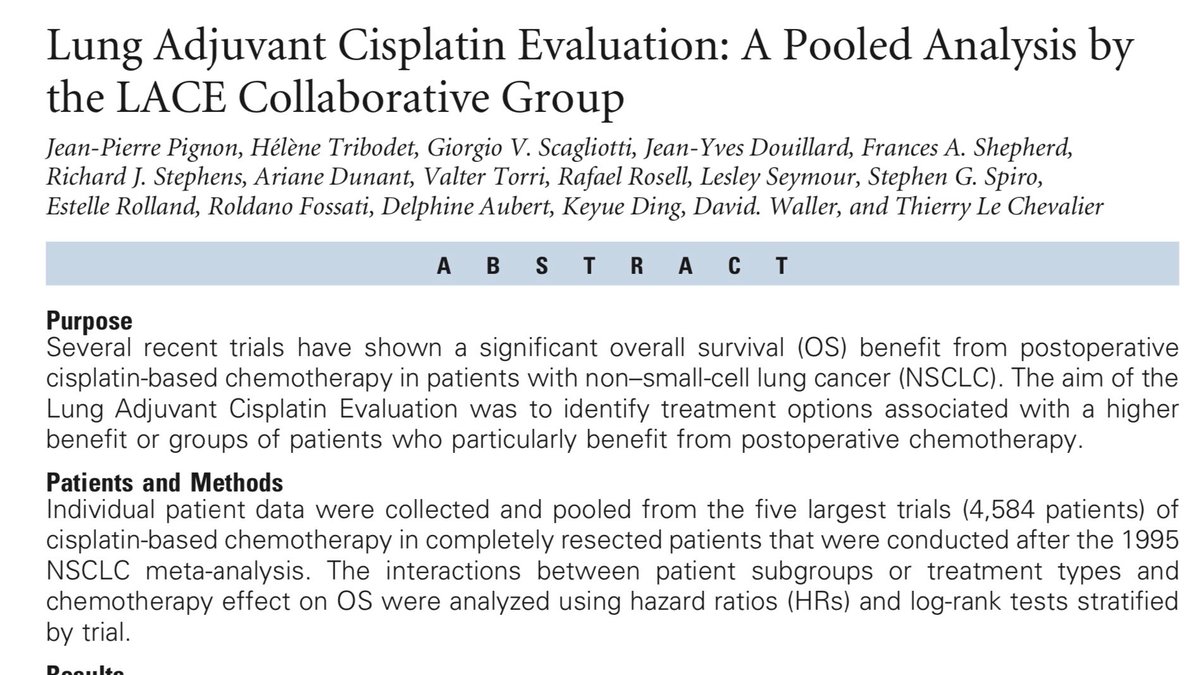
Throughout these summaries I have proposed that the randomized controlled trial is our most powerful form of evidence for the effectiveness of medical interventions. Today we’re going to look at a potentially stronger type of evidence: meta-analysis. 2/12
Meta-analysis is a systematic way of combining the results of several clinical trials that study the same question. Combining trials may give a larger sample size to elucidate subgroup effects, and may also highlight differences between trials. 3/12
24 November: And now a word from our sponsor
For Lung Cancer Awareness Month #LCAM I’m going to review 30 important lung cancer trials over 30 days. These posts are directed at non-medical professionals, with descriptions of the results and of what makes a good trial. #lcsm 1/16
For Lung Cancer Awareness Month #LCAM I’m going to review 30 important lung cancer trials over 30 days. These posts are directed at non-medical professionals, with descriptions of the results and of what makes a good trial. #lcsm 1/16

To date we have reviewed at a couple of trials looking at the role of surgery in multidisciplinary management (Nov 6 & 8). Today we’ll look at a proper randomized trial of two surgical procedures for staging the mediastinum (the middle of the chest, between the lungs). 2/16
23 November: ALEX and clarity
This year for Lung Cancer Awareness Month #LCAM I’m going to summarize 30 important lung cancer trials over 30 days. These posts are directed at non-medical professionals, with descriptions of the results and of what makes a good trial. 1/11 #lcsm
This year for Lung Cancer Awareness Month #LCAM I’m going to summarize 30 important lung cancer trials over 30 days. These posts are directed at non-medical professionals, with descriptions of the results and of what makes a good trial. 1/11 #lcsm

Today we’re returning to ALK-positive lung cancer. Way back on 5 November we looked at the PROFILE study that established crizotinib rather than chemotherapy as the second-line standard of care.
Today’s study compares crizotinib to a newer generation of ALK drug, alectinib. 2/11
Today’s study compares crizotinib to a newer generation of ALK drug, alectinib. 2/11

This trial enrolled 303 previously untreated people between 2014 and 2016. Primary outcome was progression-free survival, with an 80% power to detect an increase in median PFS form 10.9 to 16.8 months. Particular attention was paid to brain metastases. 3/11
22 November: PACIFIC, intention to treat
For Lung Cancer Awareness Month #LCAM I’m going to summarize 30 important lung cancer trials over 30 days. These posts are directed at non-medical professionals, with descriptions of the results and of what makes a good trial. #lcsm 1/13
For Lung Cancer Awareness Month #LCAM I’m going to summarize 30 important lung cancer trials over 30 days. These posts are directed at non-medical professionals, with descriptions of the results and of what makes a good trial. #lcsm 1/13

We previously looked at locally-advanced lung cancer on 4, 6, and 9 November. We have established standard treatment as ~60 Gy radiotherapy with concurrent chemotherapy for those that are not resectable by lobectomy. Today’s trial looked at adding immunotherapy. 2/13 

The antibody in this trial is durvalumab. Like the previously mentioned pembrolizumab (Nov 13, 16) and nivolumab (Nov 19), durvalumab inhibits the interaction of PD-1 and PD-L1. Unlike the other two, durvalumab binds to PD-L1. Clinically, the difference seems negligible. 3/13
21 November: Screening part 2
This year for Lung Cancer Awareness Month #LCAM I’m going to summarize 30 important lung cancer trials over 30 days. These posts are directed at non-medical professionals, with descriptions of the results and of what makes a good trial. #lcsm 1/17
This year for Lung Cancer Awareness Month #LCAM I’m going to summarize 30 important lung cancer trials over 30 days. These posts are directed at non-medical professionals, with descriptions of the results and of what makes a good trial. #lcsm 1/17

Yesterday we went over the major results of the NLST. We discussed screening in general and the concept of overdiagnosis in particular. Today we’ll look at the Dutch-Belgian NELSON study, the next largest randomized study in this field. 2/17
NELSON enrolled 13 195 people between 2000 and 2004. They were randomly assigned to no screening, or to CT scans at baseline, 1 year, 3 years, and 5.5 years later. The trial was powered to detect a 25% reduction in lung cancer mortality over the 10 years from enrollment. 3/17
20 November: Screening part 1
This year for Lung Cancer Awareness Month #LCAM I’m going to summarize 30 important lung cancer trials over 30 days. These posts are directed at non-medical professionals, with descriptions of the results and of what makes a good trial. #lcsm 1/17
This year for Lung Cancer Awareness Month #LCAM I’m going to summarize 30 important lung cancer trials over 30 days. These posts are directed at non-medical professionals, with descriptions of the results and of what makes a good trial. #lcsm 1/17

I’m going to spend the next two days on screening studies. Honestly, I have some trepidation in posting on this topic. There are advocates of screening and sceptics about screening, both vocal, and I’m probably going to disagree with most of them. Let’s look at some evidence.2/17
I’m going to review two large screening studies: NLST and NELSON.
Screening is the testing of asymptomatic individuals at risk for a disease. An underlying assumption is that earlier detection results in better outcomes. For many cancers this seems to be the case. 3/17
Screening is the testing of asymptomatic individuals at risk for a disease. An underlying assumption is that earlier detection results in better outcomes. For many cancers this seems to be the case. 3/17
19 Nov: Ipi-nivo-meso, stratified randomization
For Lung Cancer Awareness Month #LCAM I’m going to review 30 important lung cancer trials in 30 days. These posts are directed at non-medical professionals, with descriptions of the results and of what makes a good trial.#lcsm 1/18
For Lung Cancer Awareness Month #LCAM I’m going to review 30 important lung cancer trials in 30 days. These posts are directed at non-medical professionals, with descriptions of the results and of what makes a good trial.#lcsm 1/18

We previously discussed a mesothelioma trial on 8 November. On 15 November I also briefly alluded to a study that established platinum/pemetrexed as the standard chemotherapy, in 2004. Today’s study expands the use of immunotherapy into this disease. 2/18
All of our previous immunotherapy trials (13, 16 Nov) have been about pembrolizumab, an antibody to PD-1. This trial uses the similar antibody, nivolumab, along with a second antibody, ipilimumab, which targets a different part of the immune response, called CTLA-4. 3/18
18 November: Pemetrexed & placebo
For Lung Cancer Awareness Month #LCAM I’m going to summarize 30 important lung cancer trials over 30 days. These posts are directed at non-medical professionals, with descriptions of the results and of what makes a good trial. #lcsm 1/13
For Lung Cancer Awareness Month #LCAM I’m going to summarize 30 important lung cancer trials over 30 days. These posts are directed at non-medical professionals, with descriptions of the results and of what makes a good trial. #lcsm 1/13

Today’s trial takes us back to 2005, when standard first-line platinum doublet was given for 4-6 cycles, followed by a treatment break. People would be followed, usually for a few months, and when their cancer worsened they would get second-line chemo, often pemetrexed. 2/13
This trial asked the question of whether people would live longer if the pemetrexed started immediately after first-line chemo (maintenance treatment), rather than waiting and using it in second line. At the time of this study, pemetrexed was not used in first-line. 3/13
17 Nov: Exploring exploratory analyses
For Lung Cancer Awareness Month #LCAM I’m going to summarize 30 important lung cancer trials over 30 days. These posts are directed at non-medical professionals, with descriptions of the results and of what makes a good trial. #lcsm 1/14
For Lung Cancer Awareness Month #LCAM I’m going to summarize 30 important lung cancer trials over 30 days. These posts are directed at non-medical professionals, with descriptions of the results and of what makes a good trial. #lcsm 1/14
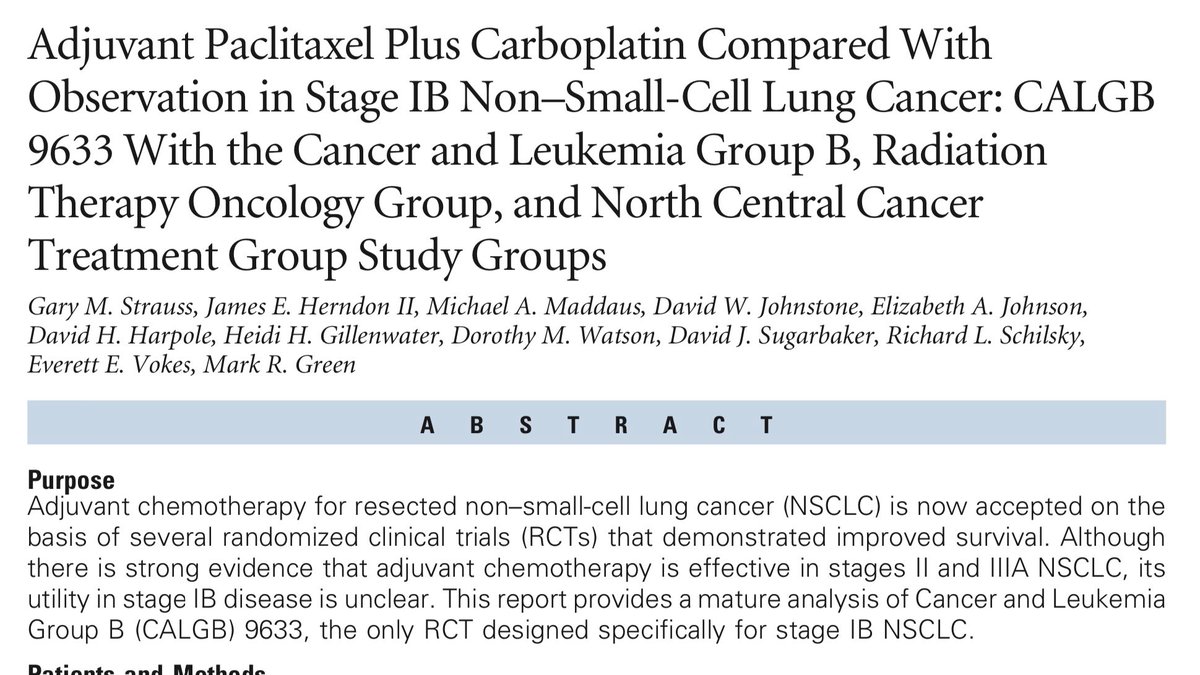
We have previously looked at adjuvant chemotherapy (Nov 2) and osimertinib (14 November). Today we’ll look at another influential adjuvant study, and ask whether it ought to be as influential as it is. 2/14
This trial enrolled people exclusively who had had stage Ib cancers removed surgically. In the staging system in use at the time, stage Ib was any tumour larger than 3 cm, with no lymph nodes involved (today many of these would be given a higher stage). 3/14
16 November: The right side of the curve
For Lung Cancer Awareness Month #LCAM I’m going to summarize 30 important lung cancer trials over 30 days. These posts are directed at non-medical professionals, with descriptions of the results and of what makes a good trial. #lcsm 1/14
For Lung Cancer Awareness Month #LCAM I’m going to summarize 30 important lung cancer trials over 30 days. These posts are directed at non-medical professionals, with descriptions of the results and of what makes a good trial. #lcsm 1/14

In our previous discussion of immunotherapy (13 Nov) we talked about the expression of PD-L1 on tumour cells. At the time of this study (2014) there was some evidence that tumours with more cells expressing PD-L1 were more likely to benefit from immunotherapy. 2/14 

This trial enrolled people with metastatic lung cancer (non-EGFR, non-ALK) where >50% of tumour cells expressed PD-L1. About one third of NSCLC meet this criterion. They were randomized to either standard chemotherapy, or to pembrolizumab immunotherapy for up to two years. 3/14
15 November: Vitamins, a note to trainees
For Lung Cancer Awareness Month #LCAM I’m going to summarize 30 important lung cancer trials over 30 days. These posts are directed at non-medical professionals, with descriptions of the results and of what makes a good trial. #lcsm 1/14
For Lung Cancer Awareness Month #LCAM I’m going to summarize 30 important lung cancer trials over 30 days. These posts are directed at non-medical professionals, with descriptions of the results and of what makes a good trial. #lcsm 1/14

To date we have looked at trials that compared different treatments. Today, we’re going to look at something a little different: a trial of the schedule of supportive medications that are given along with chemotherapy, in this case vitamin B12 and folic acid with pemetrexed. 2/14
We have seen how pemetrexed has become one of the most commonly used chemotherapy drugs in non-squamous NSCLC (11, 13 November). Compared to other chemo drugs we think that it has a relatively good safety profile, but it was not always so. 3/14
November 14: Controversy, hierarchy
For Lung Cancer Awareness Month #LCAM I’m going to summarize 30 important lung cancer trials over 30 days. These posts are directed at non-medical professionals, with descriptions of the results and of what makes a good trial. #lcsm 1/17
For Lung Cancer Awareness Month #LCAM I’m going to summarize 30 important lung cancer trials over 30 days. These posts are directed at non-medical professionals, with descriptions of the results and of what makes a good trial. #lcsm 1/17

This is the most recent study we’ve looked at so far, from 2020. You may recall that adjuvant chemotherapy (after surgery) increases the chances of cure for early stage lung cancer (Nov 2), and also that we have good oral medications for lung cancer with EGFR mutation (Nov 7, 12)
This trial enrolled people who had resected lung cancer with EGFR mutation. They were allowed to have adjuvant chemotherapy. They were then randomized to three years of the EGFR TKI osimertinib, or three years of placebo. 3/17
13 November: Our 1st Keynote, HR
This year for Lung Cancer Awareness Month #LCAM I’m going to summarize 30 important lung cancer trials over 30 days. These posts are directed at non-medical professionals, with descriptions of the results and of what makes a good trial.#lcsm 1/17
This year for Lung Cancer Awareness Month #LCAM I’m going to summarize 30 important lung cancer trials over 30 days. These posts are directed at non-medical professionals, with descriptions of the results and of what makes a good trial.#lcsm 1/17

The uptake of immunotherapy in lung cancer has been rapid and widespread. In 2014 it was research only: in 2021 it is used in all types of lung malignancies, in almost all stages of disease. We will discuss at least six immunotherapy studies in the remainder of the month. 2/17
Lymphocytes are white blood cells that should lead an immune response to tumours. In some cases, tumour cells have a protein on the surface called PD-L1 that binds to a protein called PD-1 on lymphocytes, and serves to “turn off” that part of the immune response. 3/17
12 November: FLAURA, intro to power
For Lung Cancer Awareness Month #LCAM I’m going to summarize 30 important lung cancer trials over 30 days. These posts are directed at non-medical professionals, with descriptions of the results and of what makes a good trial. #lcsm 1/15
For Lung Cancer Awareness Month #LCAM I’m going to summarize 30 important lung cancer trials over 30 days. These posts are directed at non-medical professionals, with descriptions of the results and of what makes a good trial. #lcsm 1/15

Today we are back to looking at EGFR-mutated lung cancer, with the FLAURA trial comparing osimertinib to either gefitinib or erlotinib in the first-line setting. Today’s discussion is from two papers, one looking at Progression Free Survival, the other at Overall Survival 2/15 

You may recall from the IPASS study (7 November) that gefitinib improved PFS compared to chemo, with fewer side effects.
Erlotinib was another drug similar to gefitinib.
Osimertinib was the next-generation of EGFR drugs, with several potential improvements. 3/15
Erlotinib was another drug similar to gefitinib.
Osimertinib was the next-generation of EGFR drugs, with several potential improvements. 3/15
11 November: Non-inferiority, pemetrexed
For Lung Cancer Awareness Month #LCAM I’m going to summarize 30 important lung cancer trials over 30 days. These posts are directed at non-medical professionals, with descriptions of the results and of what makes a good trial. #lcsm 1/11
For Lung Cancer Awareness Month #LCAM I’m going to summarize 30 important lung cancer trials over 30 days. These posts are directed at non-medical professionals, with descriptions of the results and of what makes a good trial. #lcsm 1/11

Today we are back to looking at a study of chemotherapy for metastatic non-small cell lung cancer (NSCLC). Our last study in this area (3 November) established the notion that all platinum doublets were more or less the same. Today’s study, from 2008, overturned that consensus.
This was a trial comparing cisplatin-gemcitabine (standard) with cisplatin-pemetrexed. Pemetrexed is administered in a more convenient schedule than gemcitabine, and likely causes fewer side effects. Because of these advantages, the study was designed for noninferiority. 3/11
10 November: CONVERT and CIs
This year for Lung Cancer Awareness Month #LCAM I’m going to summarize 30 important lung cancer trials over 30 days. These posts are directed at non-medical professionals, with descriptions of the results and of what makes a good trial. #lcsm 1/15
This year for Lung Cancer Awareness Month #LCAM I’m going to summarize 30 important lung cancer trials over 30 days. These posts are directed at non-medical professionals, with descriptions of the results and of what makes a good trial. #lcsm 1/15

To date in these tweets I have loosely used the term “lung cancer” to refer to non-small cell lung cancer (NSCLC), by far the commonest type of lung cancer. Today we’ll look at a trial in small cell lung cancer. 2/15
Small cell cancer is characterized by rapid growth and early metastasis. Initially very chemo responsive, it is resistant to treatments at the time of recurrence. If restricted to one side of the chest (limited stage) it can be treated with chemoradiation with a chance of cure.
9 November: RTOG 0617 & Interim Analysis
For Lung Cancer Awareness Month #LCAM I’m going to summarize 30 important lung cancer trials over 30 days. These posts are directed at non-medical professionals, with descriptions of the results and of what makes a good trial.#lcsm 1/15
For Lung Cancer Awareness Month #LCAM I’m going to summarize 30 important lung cancer trials over 30 days. These posts are directed at non-medical professionals, with descriptions of the results and of what makes a good trial.#lcsm 1/15
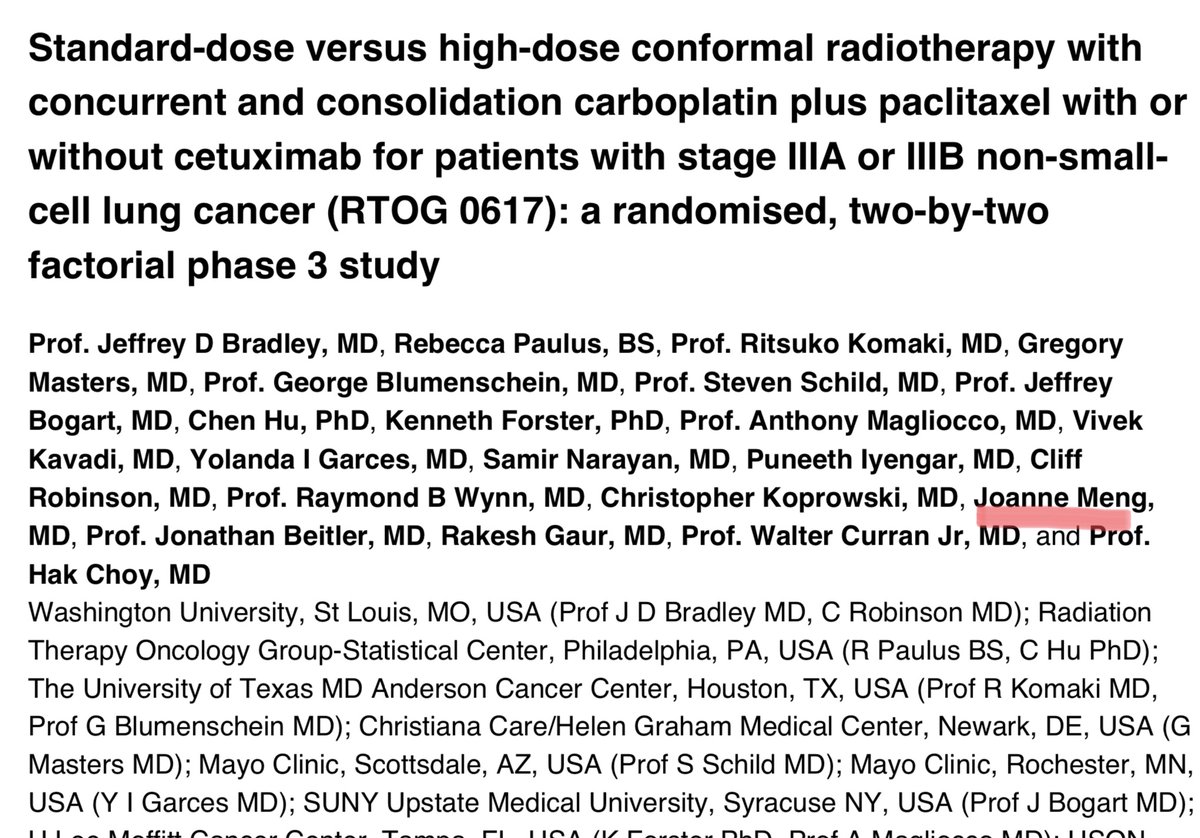
Today we have another trial in locally advanced lung cancer. By the time of this trial (2006) the established standard treatment was a radiation dose of 60 Gy plus concurrent chemotherapy. This trial looked at higher radiation doses, and at the new drug, cetuximab. 2/15
Patients were randomized twice: to either 60 or 74 Gy, and to either receive cetuximab or not. This created four arms (60 or 74 Gy, each with or without cetuximab). The cetuximab didn’t add anything, and I’m not going to focus on it in our discussion. 3/15




